
Substrates for growing oyster mushrooms are made from various plant materials. In this article I tell you what you can use as a mushroom substrate.
Table of Contents
So, talking about the most common raw materials for oyster mushroom substrates.
Can you use straw for mushrooms? Yes, you can.
At the same time, you need to understand that the straw of different plants has different properties and composition. Let's take a closer look.
Straw substrate for oyster mushrooms is one of the most common types of substrate.
It is flattened and crushed with a straw cutter.
When crushed, the hollow stem is flattened with a rupture of the internode, since a large number of pathogen spores are located there.
Moreover, straw flattening is much more effective in preventing overgrowth problems than chopping.
Therefore, at large industrial enterprises they do not grind, but already soaked raw materials are crushed by tractors.
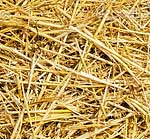 Good straw cutters, by the way, not only grind, but, most importantly, cut the stem along. In this case, the internode is torn, and all cavities are well steamed. Any straw fraction is suitable if the stem is flattened. If the straw is only cut, then segments 5-10 cm long are desirable. The straw cutter should grind evenly so that the fine fraction of 1 cm and smaller is no more than 5%.
Good straw cutters, by the way, not only grind, but, most importantly, cut the stem along. In this case, the internode is torn, and all cavities are well steamed. Any straw fraction is suitable if the stem is flattened. If the straw is only cut, then segments 5-10 cm long are desirable. The straw cutter should grind evenly so that the fine fraction of 1 cm and smaller is no more than 5%.
Hay does not have hollow stalks, but it needs to be crushed to be evenly distributed throughout the mass. After all, there is too much nitrogen in hay, sometimes alfalfa contains up to 3.5-4 units of it according to the Kjeldahl method. Chopped hay is evenly distributed throughout the substrate and the mycelium absorbs nutrients better.
Large lumps of hay in one place do not allow hot water to pass through during hydrothermia and often cause localized rotting, which will eventually spread to the entire bag.
Therefore, hay is not ground separately, but added in small portions when crushing straw bales.
For 100 kg of dry straw take from 5 to 15 kg of hay, depending on its quality.
For example, the straw of winter barley is much tougher than that of spring barley.
Triticale has a very hard stem.
When compiling compositions, consider this fact - hard stems absorb water worse.
However, they almost do not crumple, therefore they give the substrate a structural springiness, which makes it possible to achieve the required density.
If your area receives sufficient rainfall during grain ripening that stops three weeks before harvest, the straw will likely have a good nitrogen content of 0.5-0.7 (Kjeldahl method).
In dry years, it is only 0.2-0.3. For an oyster mushroom, this is very little. Therefore, legume hay must be added to the straw.
Rye straw tends to have a higher N than wheat straw. Although, to a large extent this is due to the conditions for growing cereals.
When you choose which field to harvest straw from, do a nitrogen analysis using the Kjeldahl method in an agrochemical laboratory. It is impossible to do it at home.
It often happens that higher-quality raw materials are not much more expensive, so it is more profitable to buy it.
Rice straw is used to grow oyster mushrooms, however, it has several disadvantages.
Firstly, it is quite difficult to chop it, and unchopped straw gives a smaller yield of mushrooms.
 Secondly, adding other components to the rice straw substrate often does not increase yield.
Secondly, adding other components to the rice straw substrate often does not increase yield.
And finally, it contains a lot of silica. Because of this, the mycelium absorbs less nutrients, and the mushrooms have a fragile structure and some rigidity of the mushroom tissue.
Therefore, if the main component of your substrate is rice (paddy) straw, you will need to conduct experiments to understand how to formulate the substrate mixture.
If you Google “rice straw for oyster mushrooms,” you will find articles that examine the effects of other substrate components on yield. Read them, perhaps some of the proposed raw materials are available in your region.
The stems that remain after harvesting peas and soybeans can be conventionally called "straw".
It is used in substrate compositions no more than 20-30%. The percentage of addition is determined by the nitrogen in specific samples and the stiffness of the stems.
I recommend using this straw for xerothermy and pasteurization in tunnels.
How is alfalfa straw different from hay?
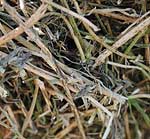 Alfalfa straw is obtained when alfalfa is harvested for seed. Hay is harvested when alfalfa is just beginning to bloom.
Alfalfa straw is obtained when alfalfa is harvested for seed. Hay is harvested when alfalfa is just beginning to bloom.
Straw has many coarse stems and almost no leaves.
The nitrogen content is 1-1.3.
Alfalfa seeds ripen in late summer - early autumn, so when harvesting straw, make sure that there are no hard, thick stems of weeds among it. They reduce the nutritional value of the raw material and can damage the straw cutter.
Also because of this, overgrowing of mycelium can be problematic.
We crushed alfalfa straw separately, for preliminary crushing. From this, the straw cutter knives are very dull, it is necessary to have a spare set of them.
Then the resulting pieces of stems were thrown in small heaps into a straw cutter along with wheat and barley straw.
The husk has N from 0.6 to 1. A small amount of fragments of sunflower kernels increases the nutritional value of the husk. If there are many kernels, the substrate becomes moldy.
In general, the number of pathogen spores in sunflower husks is much lower than in straw.
Therefore, according to the hydrothermal method, it is kept in hot water for half the time than straw. The processing temperature in both situations is the same.
How to determine the husk is suitable for growing an oyster mushroom block?
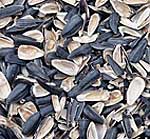 Raw material requirements:
Raw material requirements:
If the husk is not fresh, stale, it is especially important to check it for moisture and look for mold balls.
When stored in a dry room, where there are few mice, the husk practically does not change its properties - it can be used.
If you go into the warehouse, and there is a smell of dampness or mold, the husk is not crumbly and stinks of mold, it is better not to buy it. With hydrothermia, you will not get rid of the spores that have already formed there in myriad numbers.
It absorbs too much moisture when steaming, and it is very difficult to reduce it, so it is better not to use such a husk. When adding such husks to straw, take it no more than 20%.
If the husk has a high oil content, you need to monitor the pH. As a result of the saponification reaction of such husks, when lime is added, the pH may rise less than necessary. Therefore, add more lime, controlling the result with a pH meter.
This is why I recommend checking the pH at every sowing, especially if a new batch of husks has arrived.
Does the increased oil content affect the gas exchange in the mushroom block, the overgrowth rate and the yield?
I don't have hard, verified facts, but logically, this could make it harder for nutrients to dissolve.
In recent years, finding sunflower husks has been problematic in many regions. Fuel briquettes, granules, pellets began to be mass-produced from them.
Pellets can be used as a raw material if no foreign impurities are added to them.
First you need to test on a small batch, if there is a good overgrowth of mycelium, without damage, you can use it.
Nitrogen within 0.5-0.7.
Buckwheat husks are used in multicomponent mixtures.
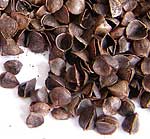
It is impossible to make a substrate only from it. Since, depending on the quality of the husk, the substrate either absorbs too much moisture, or conversely, does not absorb enough water.
If you are experimenting and using only buckwheat husks, wait until the mycelium grows in the first batch of mushroom blocks. If the blocks grow well, and the amount of the crop will please you, you can continue.
Please note that the hygroscopicity of buckwheat husks and sunflower husks is very high, it easily absorbs moisture.
At a moisture content above 16%, microbiological activity begins in the raw material, and self-heating in the pile is possible.
Therefore, store the husk in a dry, ventilated room, in polypropylene bags (such as sugar bags) for a short time: a month or two, no longer.
I saw storage in layers at one enterprise: the husk was layered with fine wheat straw. This worked quite effectively - the straw protected the husk from moisture adsorption.
Often on the Internet there are ideas to work with bran, because it contains many nutrients for mushrooms.
For hot water pasteurization and so-called cold pasteurization methods, this is a bad idea.
Bran often harms the substrate - instead of oyster mushroom mycelium, Trichoderma mold grows in it.
If you still want to use them in these methods, fry the bran separately and sprinkle the steamed mixture evenly on the table in a clean place.
How much bran can I add?
This depends on the % of nitrogen that is in the main component of the substrate - husk or straw. Start with 3% and watch the batch grow. If mold starts to form, stop experimenting.
If you are sterilizing your substrate, the main ingredient is important. If you are using hardwood sawdust, which has a small amount of nitrogen, you can add more bran.
However, you cannot add any components at random.
You need to know the amount of nitrogen in each to create the formula.
Ultimately, the total nitrogen of the sterile oyster mushroom block should be 0.75 to 0.9, and the carbon/nitrogen ratio between 55 and 60.
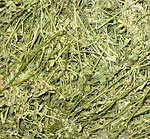 Alfalfa hay increases the nitrogen content in the substrate.
Alfalfa hay increases the nitrogen content in the substrate.
The addition of alfalfa markedly increases yields when the substrate is made by xerothermia or tunnel pasteurization.
Grassland hay, made up of various grasses, can have between 1 and 2 N, depending on which grasses it contains.
Hay cannot be used as the main component. Meadow hay has a too soft structure, as a result of which the substrate becomes waterlogged and rots.
Submit your raw materials for nitrogen analysis according to Kjeldahl in the agro-laboratory.
It is especially important to do such an analysis for hay.
If nitrogen in straw varies under different growing conditions from 0.25 to 0.5 (0.6 is extremely rare), then in legume hay (even of the same species!) It can be from 1.2 to 4.2.
Mix 3-4 kg of raw materials taken from different bales or bags, make an average sample and submit for analysis.
When you have the results of the analysis in your hands, the composition of the raw materials is calculated according to the so-called cross formula:
the mass fraction of hay is equal to the value of the fraction, where the numerator is the difference between the values of substrate nitrogen and straw nitrogen; and the denominator is the difference between hay nitrogen and straw nitrogen
For example:
| substrate nitrogen | 0,78 |
| hay nitrogen | 3,55 |
| straw nitrogen | 0,43 |
| mass fraction of hay | 0,11 |
0.78-0.43/3.55-0.43 is equal to 0.11.
In other words, in order to have a substrate with a nitrogen content of 0.78 at the output, it is necessary to take 11% hay and 89% straw.
The calculation is based on dry matter, and if the components have the same moisture, you can immediately use this formula. If the moisture content of the raw materials is different, it is necessary to recalculate the number of components, taking into account the moisture content. That is, take not 11% of the hay that is actually there, but first calculate how much dry matter is contained in that particular hay and straw that you will use.
Straw and hay must be prepared immediately for the whole season during summer field work.
In the summer the raw materials are dry (6-10% moisture content) and, putting them in storage, you will be sure of the quality and proper storage. If you buy bales of straw and hay during the season, you must remember that at a moisture content of about 20%, the activity of microorganisms begins, the stack begins to warm up with the release of heat, and this process is not always noticeable on the surface of the bales.
Dry bean hay in bales should be stored under a shed or in a covered warehouse. Bales lying in the open air heat up and deteriorate within two to three months. This is due to the presence of protein foods readily available to bacteria and the ability to quickly draw in moisture from the surrounding air.
Bulrush (Scírpus) is also called cattail and reed (Phragmites australis). These are three different plants.
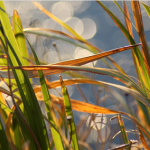 They are crushed and processed in the same way as straw.
They are crushed and processed in the same way as straw.
But their stems are much tougher. If the heat treatment is carried out for less than 6 hours, wet spots and the development of trichoderma are very likely.
It is better not to use the soft parts of the reed with a panicle, as they are easily waterlogged.
There is no need to expect high yields from reeds, there is little nitrogen there.
I do not recommend using reeds to steam a large number of blocks. If you have a desire, you can experiment - mix with soft meadow hay and determine the yield.
